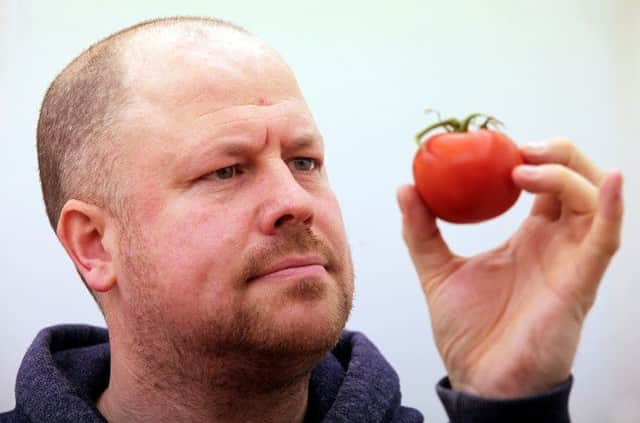Tomato man fighting to save our salads: Why gardeners must be on red alert


East Boldon boffin Colin Tosh has overseen a research study which reveals selective growing for larger and redder tomatoes has left the tasty food a prime target for predators.
Studies by a PHD student at Newcastle University have shown that wild tomatoes have a natural line of defence against destructive whitefly, but this is being bred out of them – leading to a costly trade-off in the shape of an intensive pest control regime.
Advertisement
Hide AdAdvertisement
Hide Ad

Wild tomatoes release a sap which “gums up” the pest’s feeding tube.
Mr Tosh, 42, who is a biology lecturer at the university, says PHD student Thomas McDaniel has spent more than three years conducting the study, which concludes a “super tomato” could be bred to cope with flying threats.
He said: “I think gardeners and people with allotment plots would be crying out for something like this. There could be a real niche market for these wild flowers. Diversity in general, could be lost. If they are bred out of existence, there is no going back.”
Mr McDaniel, who is based at Newcastle University’s School of Biology, says the findings highlight the natural resistance of wild plant varieties and suggests we need to “breed some of that wildness back in” instead of continuously looking for new methods of pest control.
Advertisement
Hide AdAdvertisement
Hide Ad

He said: “By selecting for certain characteristics, we have inadvertently lost some really useful ones,
“The tomatoes we buy in the supermarket may have a long shelf life and be twice as big as the wild varieties but the trade-off is an intensive and costly pest control regime– both biological and in the form of chemical pesticides.
“Our research suggests that if we can breed the whitefly resistant genes back into our commercial varieties then we can produce a super tomato that not only has all the characteristics that we have selected for but is also naturally resistant to the whitefly.”
The study, funded by the Biotechnology and Biological Sciences Research Council, found that – when given free choice – the whitefly were 80% more likely to settle and feed on the commercial tomato plants than a wild variety.
Advertisement
Hide AdAdvertisement
Hide Ad

Project supervisor Dr Barry Brogan said the findings also highlighted the importance of maintaining biodiversity.
“There has been growing interest in traditional and wild varieties of fruit and veg, driven mainly by people wanting to recapture the tastes of their childhood.”
“But actually it’s playing a vital role in protecting these older varieties and maintaining biodiversity. If we allow our wild species to be lost then we risk losing potentially useful traits that we might need at a later date.”